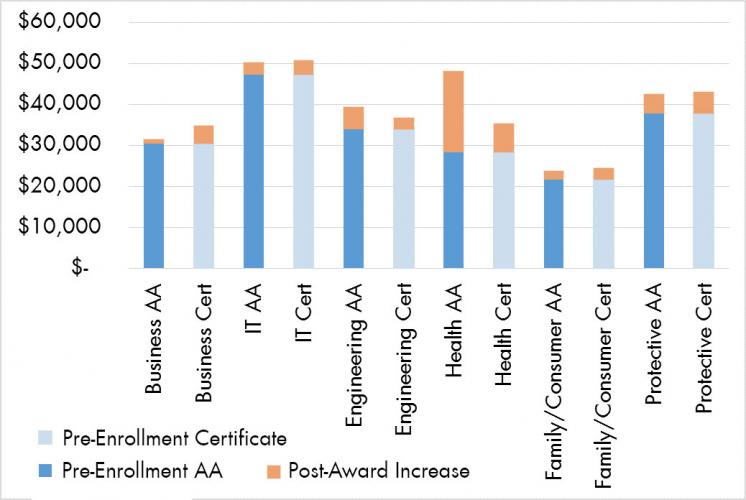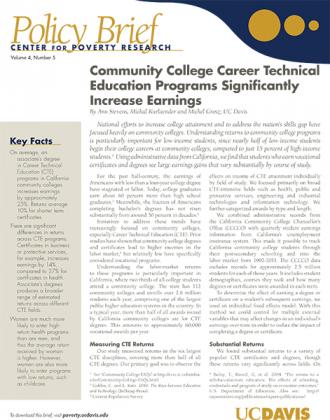Community College Career Technical Education Programs Significantly Increase Earnings
By Ann Stevens, Michal Kurlaender and Michel Grosz; UC Davis
National efforts to increase college attainment and to address the nation’s skills gap have focused heavily on community colleges. Understanding returns to community college programs is particularly important for low-income students, since nearly half of low-income students begin their college careers at community colleges, compared to just 15 percent of high-income students.[1] Using administrative data from California, we find that students who earn vocational certificates and degrees see large earnings gains that vary substantially by course of study.
For the past half-century, the earnings of Americans with less than a four-year college degree have stagnated or fallen. Today, college graduates earn about 60 percent more than high school graduates.[2] Meanwhile, the fraction of Americans completing bachelor’s degrees has not risen substantially from around 30 percent in decades.[3]
Key Facts
- On average, an associate’s degree in Career Technical Education (CTE) programs in California community colleges increases earnings by approximately 25%. Returns average 10% for shorter term certificates.
- There are significant differences in returns across CTE programs. Certificates in business or protective services, for example, increases earnings by 14%, compared to 27% for certificates in health. Associate’s degrees produce a broader range of estimated returns across different CTE fields.
- Women are much more likely to enter high-return health programs than are men, and thus the average return received by women is higher. However, women are also more likely to enter programs with low returns, such as childcare.
Initiatives to address these trends have increasingly focused on community colleges, especially Career Technical Education (CTE). Prior studies have shown that community college degrees and certificates lead to higher incomes in the labor market,[4] but relatively few have specifically considered vocational programs.
Understanding the labor-market returns to these programs is particularly important in California, where two thirds of all college students attend a community college. The state has 112 community colleges and enrolls over 2.6 million students each year, comprising one of the largest public higher education systems in the country. In a typical year, more than half of all awards issued by California community colleges are for CTE degrees. This amounts to approximately 60,000 vocational awards per year.
Measuring CTE Returns
Our study measured returns in the six largest CTE disciplines, covering more than half of all CTE degrees. Our primary goal was to observe the effects on income of CTE attainment individually by field of study. We focused primarily on broad CTE-intensive fields such as health, public and protective services, engineering and industrial technologies and information technology. We further categorized awards by type and length.
We combined administrative records from the California Community College Chancellor’s Office (CCCCO) with quarterly student earnings information from California’s unemployment insurance system. This made it possible to track California community college students through their postsecondary schooling and into the labor market from 1992-2011. The CCCCO data includes records for approximately 2.5 million students for each of those years. It includes student demographics, courses they took and how many degrees or certificates were awarded in each term.
To determine the effect of earning a degree or certificate on a student’s subsequent earnings, we used an individual fixed effects model. With this method we could control for multiple external variables that may affect changes in an individual’s earnings over time in order to isolate the impact of completing a degree or certificate.
Substantial Returns
We found substantial returns to a variety of popular CTE certificates and degrees, though these returns vary significantly across fields. On average, an Associate’s degree increased earnings by 33 percent. Shorter-term certificates increased earnings an average of 13-22 percent.
Importantly, these returns varied dramatically by field of study. Certificates (involving just six months to two years of coursework) in business or public and protective services, for example, increased earnings by 14 percent, compared to increases of 27 percent for certificates in health. Added to the average earnings levels before enrollment, as shown in the figure below, this implies annual earnings after completing a vocational program of $34,763 for those completing programs in business, $43,100 in protective services, or $35,328 in health.
Student Characteristics
Student characteristics vary considerably across programs, and these differences translate into different returns and outcomes. Figure 1 shows that even prior to enrollment, potential CTE students have earnings levels that differ substantially across the fields. For example, those enrolling in IT programs have more than double the pre-enrollment earnings of students entering programs in Family and Consumer Sciences.
Women were much more likely than men to enter health programs, and thus their average return was higher. Women’s income increased 42 percent with an associate’s degree, compared to 21 percent for men, largely driven by high returns in health programs. However, women were also more likely to enter programs with low returns, such as childcare.
These differences go beyond gender. Sixty percent of students in programs with the highest returns—health and protective services—were White, compared to 50 percent in other programs. Thus, the overall return for White students earning an associate’s degree was slightly higher, at 33 percent, compared to 29 percent for Black students and 28 percent for Hispanic students.
Supporting Human Capital Development
It has never been more crucial to find effective paths to human capital development for those who are unlikely to complete four-year academic degrees. Declining real wages and record high unemployment for those without college degrees, combined with cuts to many state programs serving these populations, make it essential to understand what programs can be most effective.
These estimates show that CTE programs can boost workers’ earnings, but that the size of returns varies by the length and type of CTE program. Information on the likely returns to specific programs,[5] such as those estimated here, should be made available to CTE students so that they understand the likely financial outcomes and can choose programs that both fit their career goals and offer meaningful wage returns.
Ann Huff Stevens is a Professor of Economics at UC Davis and Director of the Center for Poverty Research.
Michal Kurlaender is a Professor in the UC Davis School of Education.
Michel Grosz is a Ph.D. candidate in Economics at UC Davis.
The authors wish to thank the California Community College Chancellor’s Office for access to the data for this project.
1 See “Community College FAQs” at http://ccrc.tc.columbia.edu/Community-College-FAQs.html.
2 Goldin, C. and L. Katz. 2010. The Race between Education and Technology (Belknap Press).
3 Current Population Survey
4 Bailey, T., Kienzl, G, et al. 2004. “The return to a sub-baccalaureate education: The effects of schooling, credentials and program of study on economic outcomes.” U.S. Department of Education. Also see: http://capseecenter.org/publications/capsee-publications.
5 An excellent example is the California Community College Chancellor’s Office’s online portal with information on pre- and post-enrollment earnings by degree and certificate: http://salarysurfer.cccco.edu/Salaries.aspx.
#povertyresearch














